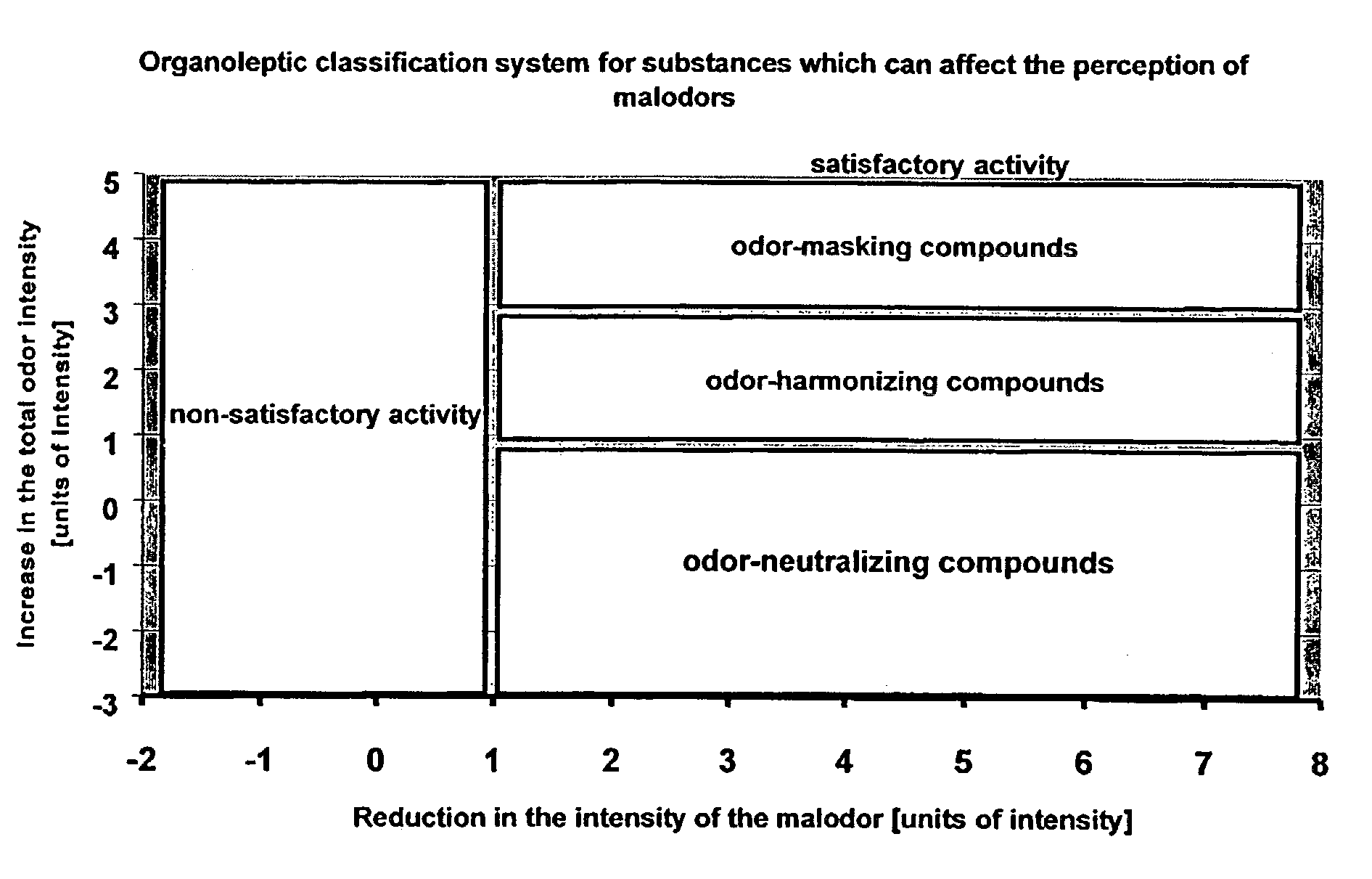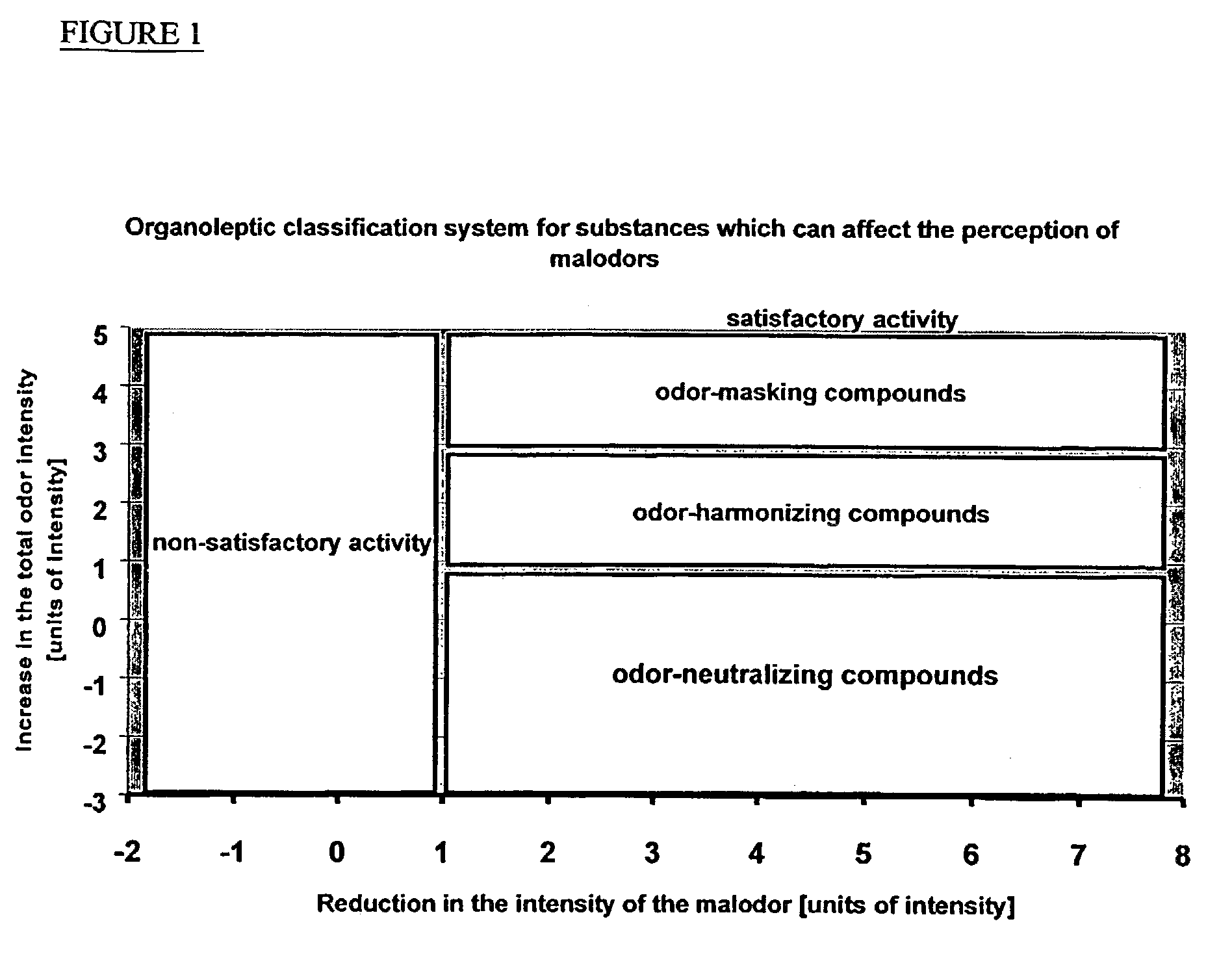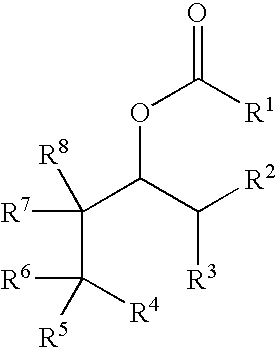Odor neutralizers
a technology of odor neutralizers and odors, applied in the field of odor neutralizers, can solve the problems of malodor, difficult to handle and solve with perfume compositions, and affect personal well-being, and achieve the effect of broadening the range of possible uses and improving the usability
- Summary
- Abstract
- Description
- Claims
- Application Information
AI Technical Summary
Benefits of technology
Problems solved by technology
Method used
Image
Examples
example 1
Production of the Esters for the Odor Neutralizers According to the Present Invention
[0159]1 mol equivalent of the alcohol to be esterified and 1.5 mol equivalents, or, in the case of diols, 3 mol equivalents, of pyridine are initially introduced into a suitable solvent such as for example toluene or methyl tert.-butyl ether. If tertiary alcohol groups are to be esterified, 0.01 mol equivalent of 4-dimethylaminopyridine is added. 1.2 mol equivalents, or, in the case of diols, 2.4 mol equivalents, of the anhydride or the chloride of the corresponding carboxylic acid are then added at 0° C. When the addition is complete the mixture is stirred at room temperature or with heating, until the reaction has ended. The progress of the reaction is monitored by gas chromatography. Working up is carried out by diluting with water, washing the organic phase with dilute sodium hydroxide solution, hydrochloric acid and soda solution, followed by evaporation. The residue is distilled...
example 2
Testing the Odor Neutralizers According to the Present Invention for their Activity Against Sweat Malodor
[0202]a) An artificial sweat malodor was prepared by mixing the following components (all values represent parts by weight):
[0203]
1% butyric acid in diethyl phthalate51% isovaleric acid in diethyl phthalate101% caproic acid in diethyl phthalate151% 3-heptyloxyacetic acid in diethyl phthalate101% 3-methyl-2-hexenoic acid in diethyl phthalate201% phenylacetic acid in diethyl phthalate0.51% thioglycolic acid in diethyl phthalate5skatole0.1diethyl phthalate34.4total100[0204]b) A test solution was prepared from 4 g of the above-described artificial sweat malodor, 20 g of Triton X100 and 76 g of water. 0.5 g of this test solution was poured drop by drop onto a wad of cotton wool which was placed in a 120 ml beaker. 0.05 g of the substance to be tested for its odor-neutralizing activity was applied to a second wad of cotton wool in the same beaker. The beaker was sealed with a lid and l...
example 3
Testing the Odor Neutralizers According to the Present Invention for Their Activity Against an Ammonia Malodor
[0206]50 mg of the substance to be tested were added to 10 g of a non-perfumed hair dye containing about 8% of a 35% ammonia solution in a 120 ml beaker and mixed. The odor of the resulting gas phase was assessed by a panel of experts in comparison with the gas phase of a beaker containing only the hair dye.
[0207]The intensity of the malodor of the standard was given a rating of 9 on a scale ranging from 0 (odorless) to 10 (extremely odorous). As shown in Table 2, the organoleptic panel assessed whether the unpleasant note of the test mixture was reduced or enhanced by the addition of the substance to be tested and whether the total odor intensity decreased or increased as a result of the substance to be tested.
[0208]The following esters displayed satisfactory neutralizing properties, i.e., a capacity for reducing the malodor of ammonia without themselves having any signific...
PUM
| Property | Measurement | Unit |
|---|---|---|
| Percent by mass | aaaaa | aaaaa |
| Percent by mass | aaaaa | aaaaa |
| Percent by mass | aaaaa | aaaaa |
Abstract
Description
Claims
Application Information
 Login to View More
Login to View More - R&D
- Intellectual Property
- Life Sciences
- Materials
- Tech Scout
- Unparalleled Data Quality
- Higher Quality Content
- 60% Fewer Hallucinations
Browse by: Latest US Patents, China's latest patents, Technical Efficacy Thesaurus, Application Domain, Technology Topic, Popular Technical Reports.
© 2025 PatSnap. All rights reserved.Legal|Privacy policy|Modern Slavery Act Transparency Statement|Sitemap|About US| Contact US: help@patsnap.com



